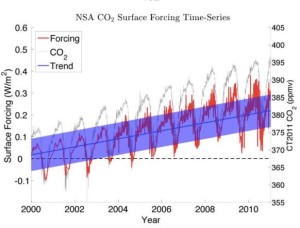UW instrument provides first confirmation of increased greenhouse effect at Earth’s surface
FOR IMMEDIATE RELEASE
02/25/15
CONTACT: Jonathan Gero, 608-265-2335, jonathan.gero@ssec.wisc.edu
UW instrument provides first confirmation of increased greenhouse effect at Earth’s surface
Observations from the Atmospheric Emitted Radiance Interferometer (AERI) – a ground-based, spectroscopic instrument designed at the University of Wisconsin-Madison Space Science and Engineering Center (SSEC) – are central to a new study confirming the effect of carbon dioxide (CO2) on the Earth’s energy balance near the surface for the first time in a field experiment.
Jonathan Gero, principal investigator for the AERI program at SSEC and co-investigator on the study, collaborated with scientists from the US Department of Energy Lawrence Berkeley National Laboratory.

North Slope of Alaska (NSA) CO2 surface forcing time-series showing: (1) the similarity between the red curve (greenhouse effect) and grey curve (CO2 concentration), and (2) the blue shading is the uncertainty in the trend. After 11 years the trend is statistically significant. Credit: Daniel Feldman, Lawrence Berkeley National Laboratory.
The researchers analyzed AERI observations at two Department of Energy field sites between 2000 and 2010, one in Oklahoma and one on the North Slope of Alaska. They measured atmospheric CO2’s capacity to trap more and more of the Earth’s energy, attributing this upward trend to rising CO2 levels from fossil fuel emissions and fires, or anthropogenic sources. The team’s findings are reported in the February 25 advance online release of the journal Nature.
The influence of atmospheric CO2 on Earth’s energy balance is well-established but had not been experimentally confirmed outside the laboratory until now. The Earth’s energy balance is the balance between solar radiation coming into the atmosphere and infrared radiation exiting the atmosphere as a result of reflection and emission processes.
If there is a sustained imbalance between incoming and outgoing energy, warming can result. This effect is known as radiative forcing. It is a measure of the amount that the Earth’s energy budget (the driver of global weather and climate) is out of balance.
According to Gero, the 11-year study specifically measured CO2’s ability to trap energy near the surface, and thus, its contributions to radiative forcing. “The results for the increase in greenhouse effect were similar for the two locations,” notes Gero.
The AERI instrument was rigorously designed by a team of scientists and engineers at SSEC in the early 1990s with accuracy as its hallmark. Now installed at locations worldwide, each site contributes to the AERI data set that spans 20 years and continues to grow. Because of its decades-long history and proven accuracy, the AERI is routinely used to validate and calibrate data from NASA and NOAA satellites.
“We must collect a highly accurate long-term record of observations. These are the conditions needed to draw conclusions about the Earth’s climate,” says Gero. “We are confident in the results because of the accuracy and reliability of the AERI instrument. It is the most accurate, robust instrument of its kind.”
The evolving role of atmospheric components such as CO2, and its radiative contributions to the surface energy balance of Earth, adds Gero, are effectively and accurately tracked with stand-alone or networks of AERI instruments.
He explained that the AERI precisely measures the thermal energy arriving at the Earth’s surface, in the infrared part of the spectrum, through remote sensing. These AERI spectral measurements are sensitive to many different components of the atmosphere: Atmospheric gases, aerosols, clouds, water vapor, and temperature, for example.
“We were able to isolate the distinct fingerprint of CO2 within the AERI spectrum and use that in our study,” said Gero. “We know CO2 concentration has been increasing but these results link the increase in surface CO2 to the greenhouse effect for the first time.”
The results from this analysis agree with theoretical predictions of the increase in the greenhouse effect due to human activity.
With nearly continuous operation during the 11-year study period, the AERI provided over 10,000 measurements of the atmosphere to support the trend calculation.
Data analysis for the two independent sites indicated the same trend: Atmospheric CO2 was responsible for a significant increase in radiative forcing, about two-tenths of a Watt per square meter per decade in mid- and high-latitudes. The researchers attributed this trend to the 22 parts-per-million increase in atmospheric CO2 between 2000 and 2010.
The rise in CO2-attributed radiative forcing was further linked to human activity in the form of fossil fuel burning and fires based on analysis of data from the National Oceanic and Atmospheric Administration’s Carbon Tracker — a global CO2 measurement system developed to monitor increases and decreases of carbon dioxide in the atmosphere.
The data, says Gero, also highlighted the influence of photosynthesis on the energy balance at the surface. The team confirmed that radiative forcing follows the same seasonal cycle as photosynthesis. Moving in tandem, the cycles show less radiative forcing in the spring when the photosynthetic process absorbs CO2 and, conversely, more radiative forcing in the winter.
SSEC’s work in the climate arena is not new. It dates back to 1959 when SSEC founder Verner Suomi conducted an experiment from a satellite platform to monitor the global energy budget. He set an early benchmark for analyzing the influence of human and naturally occurring processes on the Earth’s energy budget.
The AERI continues and extends a legacy of instrument development, and weather and climate research at SSEC. Looking to the future, said Gero, “there is ongoing research to deploy this measurement technique on satellite platforms so that we can make these types of measurements for the planet as a whole.”
Investigators on the study included Lawrence Berkeley National Laboratory scientists Daniel Feldman, Bill Collins, and Margaret Torn along with scientists from Pacific Northwest National Laboratory and Atmospheric Environmental Research, Inc. The research was supported by the Department of Energy’s Office of Science (Office of Biological and Environmental Research).
###
Jean Phillips
Featured image: AERI installation on the North Slope of Alaska. Credit: Jonathan Gero.
